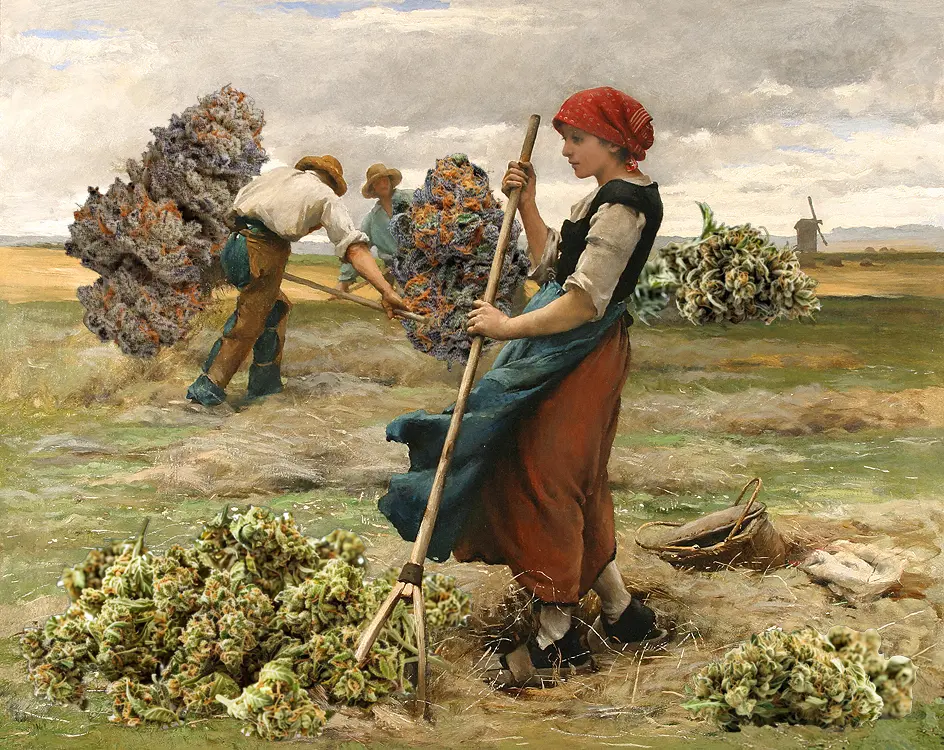October in the Emerald Triangle is a special time. Each fall, farms celebrate Harvest season, or Croptober, as it’s often called. It’s a hectic yet rewarding time, with a half year’s labor of love culminating in a few short weeks. This is especially true for the farmers taking high risks for even higher rewards by growing full-term flower under the sun, and harvesting only once per year.
Like any crop, outdoor cannabis is seasonal. In northern California’s three-county triangle known for producing the best weed in the world, seeds are popped in the early spring, and plants are in the ground once it’s warm enough. These magnificent beings grow through the summer, enjoying hot days, cool nights, and the biodiversity thriving around them. By the end of September through all of October, the plants are cut down, dried, and cured.
While full-term sungrown produces the most chemically diverse and medicinally effective flower on the market, harvesting once a year simply doesn’t work for everyone.
A number of different cultivation tactics are employed by growers navigating a retail space that demands recent packaging dates at extremely low prices. Sometimes these cultivation techniques produce totally different flower types, as with indoor and sungrown, and sometimes, they’re just speeding up the growing process, as with light dep. Every technique follows a different timeline, and produces a unique final product.
“Harvest is special because it’s the time of year when we receive the flower that was started in spring, around six months earlier,” said Joseph Haggard of Emerald Spirit Botanicals, an award-winning, family-run farm in Mendocino known for producing flower with rare combinations of cannabinoids. “It’s also the time that we harvest the new expressions from our breeding projects, so it’s an exciting time of year to see what the new crosses have to offer.”
He continues, “It can be risky to only have one harvest each year because it’s an annual crop. We spend a lot of time working to make it perfect and beautiful. If the harvest doesn’t do well, we have to wait for almost a full year to produce more.”
Because of this, many farms will employ cultivation techniques like light deprivation, or grow indoors, to increase yield and revenue.
Here is a rundown of different cultivation methods.
Full-Term Sungrown
Full-term sungrown is the most natural way to grow cannabis, and any other plant for that matter. This is how weed was originally grown, until law enforcement forced growers into hiding and pushed cultivation indoors. Farmers who employ this tactic rely on the elements as much as they are subjected to them if something goes wrong. In my opinion, the results are unmatched.
Flourishing under the sun among pollinators, companion plants, and soil aerated with mycelium and beneficial insects, plants develop complex chemical profiles, meaning more medicinal benefits and better highs. The plants grow larger too, as they’re able to fully express themselves with minimal human intervention, as nature intended.
“There are a lot of benefits to full term flower when it comes to sustainability, but one major benefit for the end consumer experience is the considerable increase in terpene and cannabinoid diversity in full term flower compared to light dep and indoor,” said Haggard. “We have seen this documented in multiple studies and at the 2024 California State Fair Cannabis Awards with sungrown offering a high of 4.54% terpenes.”
While fantastic for the plants, the entire crop is dependent on the weather and other factors out of farmer’s control. In the Emerald Triangle, a region that is technically perfect for growing cannabis outdoors, crops tend to be more successful than those growing in newer markets like New York, where humidity is an issue, or other states where conditions may vary.
Light Deprivation
Also known as light dep, this cultivation technique revolves around tricking the plants into thinking that winter is approaching. Light exposure is controlled by covering hoop houses with tarps before it gets dark, simulating the shorter daylight hours of autumn. The growing process of the plants is expedited considerably, allowing farmers to harvest multiple times in a single season.
This technique is utilized by many farmers looking to maximize their yield, and thus cash flow, which is imperative for those navigating a nearly impossible market to succeed in.
“The reality is that small farmers have struggled to remain competitive since legalization and most of them are no longer in business,” said Haggard. “It seems to me like the majority of farmers in business today are using light assist or auto flowers in one form or another to harvest multiple times per year.”
Light dep flower can be very high quality. This very common method is not looked down upon in the industry. However, Emerald Spirit believes in honoring the plant’s natural life cycle. “We believe it is important for plant medicine to be grown in alignment with the natural rhythms of the planet, so we grow full term only.”
Indoor cultivation
Indoor cultivation is extremely popular as you can harvest as often as you want. There is little risk with this method as everything about the plant’s experience is controlled, producing visually striking buds with high THC. Regardless, it’s important to remember the only reason flower was initially grown inside was to evade law enforcement, not because it’s a better growing method in terms of final product.
There is a common misconception that indoor flower is superior to outdoor, but sungrown flower is more chemically diverse, meaning it makes you feel better. It also stays fresh longer.
“I believe sungrown lasts longer than indoor when preserved through a proper curing process,” Haggard explains. “It only takes a few hours of heavy heat to spoil a good flower no matter how it is grown. A simple formula for optimal curing is keeping the flower out of light around 60 degrees and 60% humidity. I find sungrown flower properly cured for 3-5 months produces a full bodied, flavorful and smooth burn. Different terpenes respond to cures in different ways so it can be a fun sensory experience to try single varieties at different stages of the cure.”
The consistency and high yield of indoor flower make it perfect for the current market where quantity tends to be valued over quality. It is also an energy intensive process that requires artificial lighting and all kinds of resource-heavy human intervention, making it decidedly unfriendly to the environment.
While indoor cultivation benefits the producer, it often shorts the experience of the consumer. Would you want a strawberry grown in a warehouse, or in a magical garden under the sun?
Greenhouse Cultivation
Greenhouse cultivation is becoming popular in the corporate cannabis scene, as it can offer the best of both worlds—at a cost.
This hybrid approach combines the control aspect of indoor growing with the benefits of the sun’s effect on terpene profiles and cannabinoid percentages. These greenhouses often employ the use of artificial lighting (mixed light) to bolster growing seasons, allowing for multiple harvests throughout the year.
While this method can produce good weed, you lose the tenacious spirit of flower that was grown in the biodiversity of a garden teeming with life.
To elucidate the difference, a farmer I know told me a story. Friends were visiting her farm in Humboldt. Earlier in the evening, they had discussed greenhouse growing. Her friend didn’t understand why she was saying outdoor growing is superior, as greenhouse cultivation seems like the best of both worlds. Later, they were watching the night sky on her deck. Her friend mused over the totality of the beautiful experience as the giant stars twinkled and a soft breeze rustled the trees. The farmer turned to her friend and said, “Now, would you rather watch this from a greenhouse?” And it clicked.
The cannabis plant is a spiritual entity that acts as a vector for the experience it had throughout its life. Plants grown with love in the abundance of nature produce happier highs because they are happier plants. Humans often try to control every aspect of a plant’s life cycle in an attempt to make it better, but the truth is nature does it best.
While it’s becoming harder to find small-scale farms that celebrate harvest in today’s legal market, Sespe Creek has a wide array of this rare, special breed of weed.
Take advantage of the freshest, best flower in the world hitting the shelves in the coming months, and support the farmers who have toughed it out through legalization to bring you the best medicine money can buy, at a fraction of the price of top-shelf indoor.
A tomato from an organic farm will always be superior to one grown in a warehouse. Cannabis isn’t any different.

About the Author: Lindsay MaHarry is a journalist and content creator based in California, focusing on the destigmatization of cannabis, psychedelics, and other medicinal plants and fungi. Lindsay’s work has been featured in High Times, Weedmaps, Thrillist, Uproxx, Vice, Merry Jane, Gawker, and Spin Magazine. Follow her @_oystergirl_ on Instagram. For more content, subscribe to Hot Tokes with Oystergirl on Substack.

